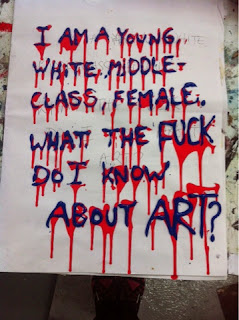Judd started his lecture by discussing the Biunial Magic Lantern by W. C. Hughes& co. c.1890. He described the lantern as being the precursor to cinema, in it's pursuit to create moving image. The magic lantern is live and has a participating element to it, in that for it to work a person has to be present, manually enabling the machine. Whereas cinema is pre-recorded and so although the audience is present there is not a necessity for a person to create the moving image in the moment.
He then went on to discuss Sea Cadettes and how they never actually go to see. How they rigorously practise these rituals and performances but never have the opportunity to put them into practise.
This links with some of his key interests within his art practise: rehearsal, the propositional and the amateur. This bled into him explaining 'interstatiality' (a state of between-ness) and 'alteration' (oscillating from one position to another).
The first of his works that he mentioned was 'I Miss' (2002) which he briefly explained was a documentary-esk film capturing a group of trainspoters in Doncaster. Then he showed 'I Love' (2003) which was another documentary styled film about a group of amateur "glamour" photographers in a seedy area. He raced through discussing all his works, 'I Will Heal You' (2007): he went to Columbia and worked with a Witchdoctor even though all the locals told him not too. She said he needed to be "clensed", he felt there was a strange power suggestion, making him wonder if it was real or monitor. By this point I was wholly unconvinced with his workforces, but it got worse!
'Close To You' (2008) was when he went to a class for amateur physics. 'The Symbol' (2009) worked with a Shaman as he wanted his work to challenge his own belief systems and other people's. To push the boundaries of his own Western atheist familiarity.
His work has several ethical and moral issues embedded into it, by his borderline insulting approach to challenging his belief systems. He puts himself into situations where we openly mocks what other people believe, and justifies this by saying that in the moment when he is a part of these people's lives he does believe as they do, and then after he leave and he's been gone for a while he remembers that he doesn't believe in what they do? Which makes me think he is either confused or just knowingly lies to them.
He followed on with talking about two other works that link in with his previous works but have titles that sound like Damien Hurst made them up. 'Conversations With The Other Side' (2009) was his attempt to blur the lines of reality and performance. Which involved a woman talking in a dreamlike state in a room in the gallery space, this was projected with a live stream to another part of the gallery space where Judd would ask questions? It was all a bit complicated and I struggled to fully understand. His work then became more of a combination of film and live action with another complicated name of 'Concerning the Differences Between the Delights of Pleasure& True Happiness' (2010) which I felt was awkward and uncomfortable to watch which was apparently intentional...
I felt that the concept behind his works were quite weak really and generally weren't my cup of tea. Although I liked the sense of continuity through his works, at least they were all vague and all linked into each other.
I felt that the concept behind his works were quite weak really and generally weren't my cup of tea. Although I liked the sense of continuity through his works, at least they were all vague and all linked into each other.











